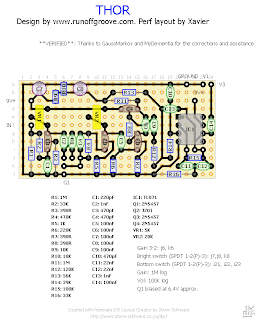The Wampler Ecstasy has recently been renamed the "Euphoria", for what reasons I'm unsure but it could be to do with a few not-so-positive forum topics popping up on google when you search for Wampler Ecstasy! I thought I'd already covered this one but a quick trip over to IVIark's tagboardeffects.blogspot.com reminded me that I haven't! The general circuit topology has been known for a while after Brian Wampler kindly got stuck in and posted a few hints over at the freestompboxes.org forum;
 |
| Gutshot of the Wampler Ecstasy Overdrive |
"When Brian created the circuit that would eventually become the Euphoria, he was working on creating a pedal that would go from clean tones to distorted tones while adding a bit of warmth. He wanted something for himself that would be dynamic, have a great sounding “gritty” tone to it yet be able to respond to the volume knob like a tube amp. Everything about Brian is in the dynamics of sound and if a pedal can't work with him dynamically, then he just can't use it.
The Euphoria is his take on that elusive tone and feel made famous by Dumble Amplifiers - smooth creaminess yet crunchy when you need it to be, yet the tonality is much more transparent than other “dumble sounding" pedals. Very responsive tone controls that interact with the pedal - they don't just “color” the sound. The controls actually affect the response and feel of the pedal, just like a great tube amp.
If you love the sound of your clean tone, and just wish you could have more “hair” on the note... a little bit of grit without any change in tonality, the Euphoria will do that with ease. PLUS it's extremely flexible... with the toggle switch in the down position you'll get a hint of fuzz along with the overdrive, it's reminiscent of the tones that "Eric Johnson" may use. With the toggle in the up position the tonality is super smooth, creamy yet crunchy when you dig into the strings.
This is reminiscent to the famous “Dumble” tone, though it's really much, much more than that. In the center position, the toggle will give you tons of crunch, or roll the gain back a bit and push the volume up and you have a superior clean boost with a 2 band EQ that's extremely transparent, but variable so you can actually turn it into an awesome treble booster just by cranking up the treble and turning the bass down."
Here's a ProGuitarShop demo video of the Ecstasy / Euphoria in action;
Now we've heard it lets see the reversed schematic;
Note that the schematic is a screen grab from modelling software - you don't need the three seperate voltage dividers which provide 4.5v, a single voltage divider will do with all of the points that need connecting to 4.5v pointed there. the 12.5k/12.5k resistors in the filter at the rear of the circuit are in fact a 25k pot with it's middle lug connected to the 22nF cap. The opamp (as seen in the gutshot above) is a JRC4580D.
So looking at the circuit layout it's pretty simple - tubescreamer/voodoo labs overdrive hybrid with a treble roll off control. The switching goes between soft/none/hard clipping options and the bass control is the same bass control as is seen on PaulC's Timmy Overdrive.
For a vero layout check out tagboardeffects.blogspot.com; http://tagboardeffects.blogspot.co.uk/2012/07/wampler-ecstasy.html
For more info here's the freestompboxes.org forum topic; http://freestompboxes.org/viewtopic.php?f=7&t=13611&hilit=wampler+ecstasy




















































